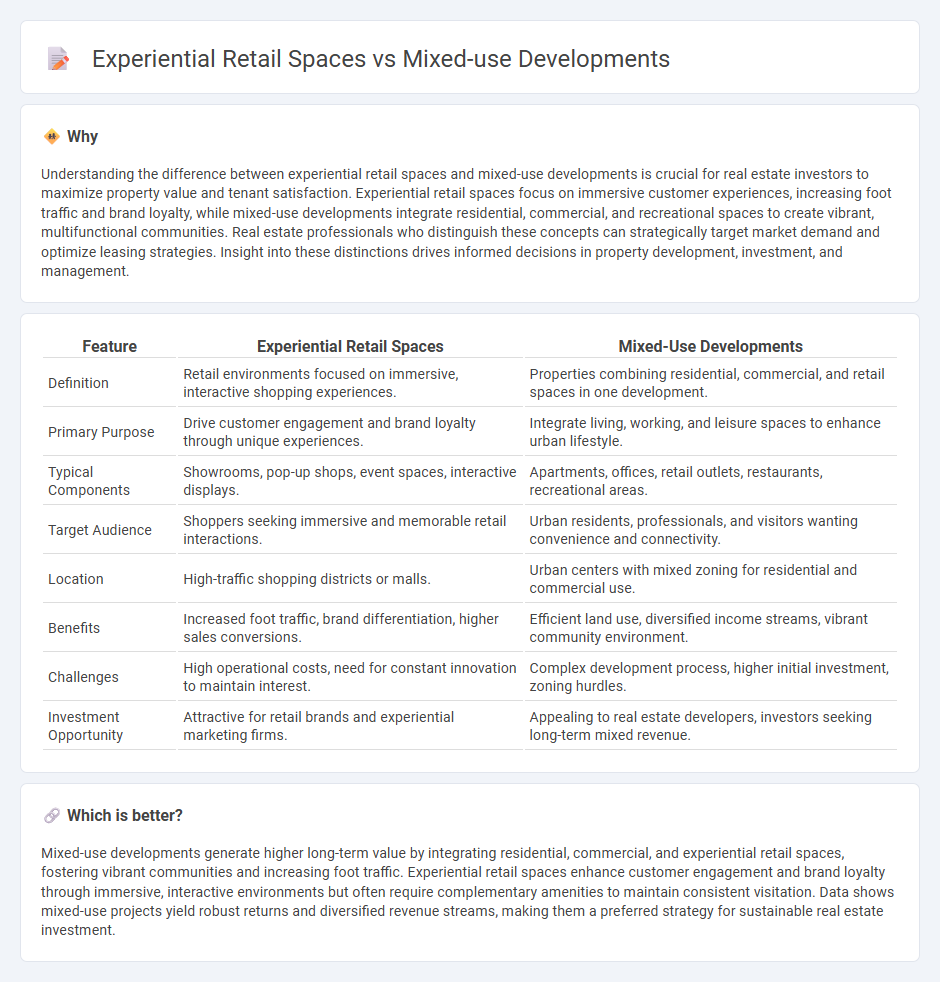
Experiential retail spaces prioritize immersive customer experiences and sensory engagement, transforming shopping into interactive and memorable encounters that increase foot traffic and brand loyalty. Mixed-use developments combine residential, commercial, and recreational spaces within a single urban area, fostering vibrant communities with convenient access to amenities and diverse lifestyle options. Explore how these innovative real estate concepts are reshaping urban living and commercial success.
Why it is important
Understanding the difference between experiential retail spaces and mixed-use developments is crucial for real estate investors to maximize property value and tenant satisfaction. Experiential retail spaces focus on immersive customer experiences, increasing foot traffic and brand loyalty, while mixed-use developments integrate residential, commercial, and recreational spaces to create vibrant, multifunctional communities. Real estate professionals who distinguish these concepts can strategically target market demand and optimize leasing strategies. Insight into these distinctions drives informed decisions in property development, investment, and management.
Comparison Table
| Feature | Experiential Retail Spaces | Mixed-Use Developments |
|---|---|---|
| Definition | Retail environments focused on immersive, interactive shopping experiences. | Properties combining residential, commercial, and retail spaces in one development. |
| Primary Purpose | Drive customer engagement and brand loyalty through unique experiences. | Integrate living, working, and leisure spaces to enhance urban lifestyle. |
| Typical Components | Showrooms, pop-up shops, event spaces, interactive displays. | Apartments, offices, retail outlets, restaurants, recreational areas. |
| Target Audience | Shoppers seeking immersive and memorable retail interactions. | Urban residents, professionals, and visitors wanting convenience and connectivity. |
| Location | High-traffic shopping districts or malls. | Urban centers with mixed zoning for residential and commercial use. |
| Benefits | Increased foot traffic, brand differentiation, higher sales conversions. | Efficient land use, diversified income streams, vibrant community environment. |
| Challenges | High operational costs, need for constant innovation to maintain interest. | Complex development process, higher initial investment, zoning hurdles. |
| Investment Opportunity | Attractive for retail brands and experiential marketing firms. | Appealing to real estate developers, investors seeking long-term mixed revenue. |
Which is better?
Mixed-use developments generate higher long-term value by integrating residential, commercial, and experiential retail spaces, fostering vibrant communities and increasing foot traffic. Experiential retail spaces enhance customer engagement and brand loyalty through immersive, interactive environments but often require complementary amenities to maintain consistent visitation. Data shows mixed-use projects yield robust returns and diversified revenue streams, making them a preferred strategy for sustainable real estate investment.
Connection
Experiential retail spaces drive consumer engagement by integrating immersive, sensory experiences that elevate traditional shopping into social destinations. Mixed-use developments enhance this dynamic by combining residential, commercial, and entertainment elements, fostering vibrant communities where experiential retail thrives. This synergy increases foot traffic and boosts property values, making real estate investments in such developments highly attractive.
Key Terms
Mixed-use developments:
Mixed-use developments integrate residential, commercial, and cultural spaces within a single urban area, enhancing convenience and fostering vibrant communities. These developments promote sustainable city living by reducing the need for long commutes and supporting local economies through diverse amenities. Explore how mixed-use developments transform urban landscapes and support dynamic lifestyles.
Zoning
Mixed-use developments integrate residential, commercial, and recreational zoning to create cohesive urban environments that support diverse activities and increase land use efficiency. Experiential retail spaces emphasize zoning that allows for interactive, entertainment-driven retail concepts designed to enhance customer engagement and extend dwell time. Explore how zoning regulations shape these innovative urban planning strategies to optimize both community experience and economic growth.
Vertical integration
Mixed-use developments achieve vertical integration by combining residential, commercial, and retail spaces within a single property, streamlining operations and enhancing tenant experience through centralized management. Experiential retail spaces integrate manufacturing, branding, and retail functions on-site to create immersive customer interactions and greater control over product presentation and quality. Explore how vertical integration transforms urban landscapes and consumer engagement in these innovative real estate models.
Source and External Links
Supporting Active Living Through Mixed-Use Developments - This article discusses how mixed-use developments promote active living by integrating residential, commercial, and civic spaces within walking distance.
Benefits of Mixed-Use Development in Urban Areas - This webpage highlights the advantages of mixed-use development in urban planning, including efficient land use and vibrant community creation.
8 Different Types of Mixed-Use Development - This guide explores various types of mixed-use developments, such as vertical, horizontal, live-work, and transit-oriented developments, each contributing to dynamic urban environments.
 dowidth.com
dowidth.com